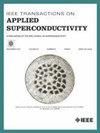基于H和T-A公式的有限元法研究高温超导绞合叠带导体电缆的交流损耗
IF 1.8
3区 物理与天体物理
Q3 ENGINEERING, ELECTRICAL & ELECTRONIC
引用次数: 0
摘要
高温超导超导(HTS)是超导核聚变研究的重要组成部分。HTS TSTC-CICC交流损耗的量化是确定热负荷和运行稳定性的关键。然而,由于高温超导TSTC-CICC的多层堆叠特性和复杂的三维扭曲结构,通过数值方法分析其电磁特性和交流损耗的过程非常耗时。为了解决快速评估HTS TSTC-CICC电缆交流损耗的需求,本文比较了不同类型的数值公式、加速策略和几何尺寸对HTS TSTC-CICC电缆交流损耗时间和精度的影响。根据磁通分布和电流分布的特点,探讨了不同模型之间误差的原理。结果表明,当HTS TSTC-CICC电缆扭节大于200 mm时,基于T-A公式和多尺度加速策略的二维数值模型可以很好地平衡计算时间和精度。仿真结果与实验数据的误差在4.3% ~ 6.2%之间,满足交流损耗评估的误差要求。本文为快速评估高温超导TSTC-CICC电缆的交流损耗提供了技术参考。本文章由计算机程序翻译,如有差异,请以英文原文为准。
Investigation of AC Losses in the HTS Twisted Stacked-Tape Conductor Cable Using H and T-A Formulation-Based Finite Element Methods
High-temperature superconducting (HTS) twisted stacked-tape conductor-cable in conduit conductors (TSTC-CICC) are critical in superconducting fusion research. The quantification of ac losses in HTS TSTC-CICC is crucial for determining the thermal load and operational stability. However, due to the multilayer stacking characteristics and complex 3-D twisted structures of HTS TSTC-CICC, the process of analyzing the electromagnetic properties and ac losses through numerical methods is time-consuming. To addresses the need for rapid assessment of AC losses in HTS TSTC-CICC cables, this article compares different types of numerical formulations, acceleration strategies, and geometric dimensions on the time and accuracy of ac loss in HTS TSTC-CICC cables. The principles behind the errors among different models are explored based on flux distribution and current distribution characteristics. The results show that when the twist pitch of HTS TSTC-CICC cables is greater than 200 mm, the 2-D numerical model based on the T-A formulation and multiscale acceleration strategies can achieve a good balance between computational time and accuracy. The error between simulation results and experimental data is between 4.3% and 6.2%, which meets the error requirements for evaluation of ac losses. This article provides a technical reference for the rapid evaluation of ac losses in HTS TSTC-CICC cables.
求助全文
通过发布文献求助,成功后即可免费获取论文全文。
去求助
来源期刊

IEEE Transactions on Applied Superconductivity
工程技术-工程:电子与电气
CiteScore
3.50
自引率
33.30%
发文量
650
审稿时长
2.3 months
期刊介绍:
IEEE Transactions on Applied Superconductivity (TAS) contains articles on the applications of superconductivity and other relevant technology. Electronic applications include analog and digital circuits employing thin films and active devices such as Josephson junctions. Large scale applications include magnets for power applications such as motors and generators, for magnetic resonance, for accelerators, and cable applications such as power transmission.
 求助内容:
求助内容: 应助结果提醒方式:
应助结果提醒方式:


